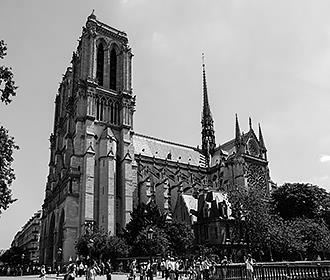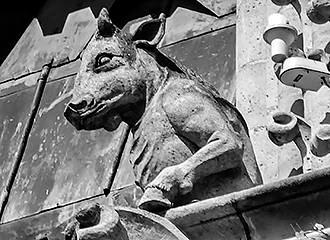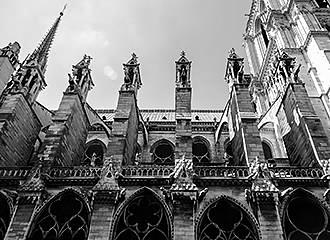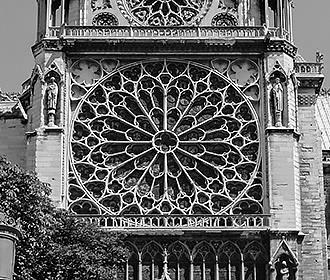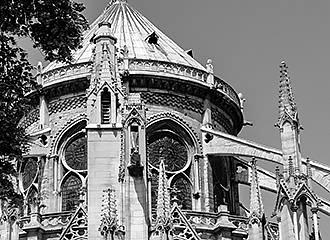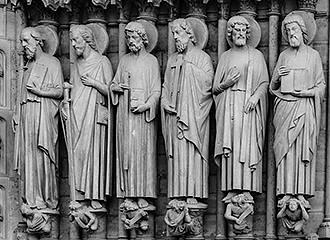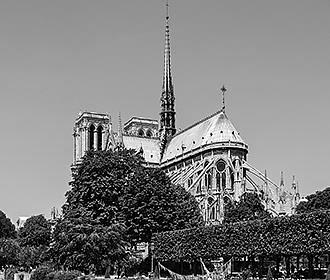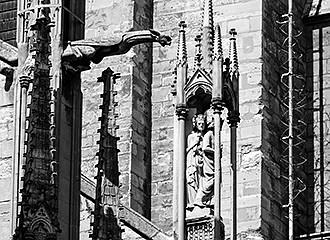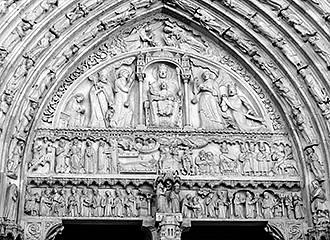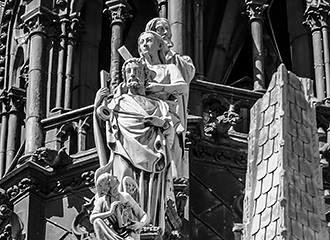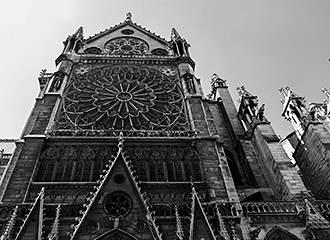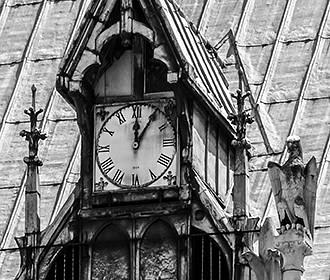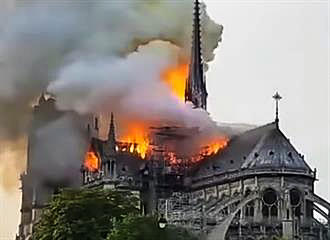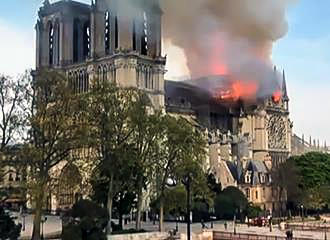Notre Dame is re-opening after devastating fire of 2019.
GREAT NEWS - LATEST UPDATES:-
A Te Deum (Latin for 'Thee, God, we praise') is planned for 15th April 2024.
The Parvis of Notre Dame and the Archaeological Crypt are now re-open to the public, as is the Pont au Double for easy pedestrian access.
The archbishop of Paris placed relics of Saint Denis, Saint Genevieve and a fragment of the Crown of the Thorns in the cockerel, and after it was blessed in the ceremony on 16th December 2023 it was placed on top of the spire, which can now be seen again, since the removal of the scaffolding surrounding it.
CASA Association volunteers offer a welcoming mission with an artistic and spiritual guide of Notre Dame conducted at 14:30pm with different languages accommodated on various days, and the meeting point is the Statue of the Virgin on the square.
Mass is still being conducted at Saint-Germain L'Auxerrois, located opposite The Louvre.
European Heritage Days of 21st and 22nd September 2024 will welcome visitors at the Parvis to see and hear lectures, demonstrations etc from various people working on the restoration such as project management and archaeologists.
The full re-opening of Notre Dame Cathedral to the public is planned for 8th December 2024.
History of Notre Dame Cathedral in Paris
The Notre Dame de Paris is a very impressive medieval gothic building located on the Ile de la Cite island in the middle of the River Seine in Paris, which has a fascinating rich history that includes the development of its remarkable architecture, and the major restorations that have taken place over the years, means that the Notre Dame Cathedral now celebrates 850 years in 2013.
Before Notre Dame Cathedral in Paris was even built
The original name for Paris was Lutetia or Lutetium and was first evangelised in the 3rd century when the Pope sent the first bishop to Paris in around the year 250, where he became Saint Denis, the Patron Saint of the city.
At that time, people had to practise their faith in secret, however he was martyred a few years later in the area of Paris on the highest point, which is now known as Montmartre and the successors lived in hiding until Emperor Constantine declared peace with the church in the early 300s.
From this time it was then possible to build Christian edifices, but the information on what was built at this time is still very sketchy even though many excavations and archaeological digs have been conducted over the years.
After several different excavations being undertaken on the Ile de la Cite, archaeologists believe that there was originally a pagan temple that was replaced by a large Christian basilica which had five naves. And through major research it was found that the original basilica was dedicated to Saint Stephen, however, it still has not been determined as to whether this was originally built in the 4th century and renovated, or whether it was built in the 7th century utilising many of the older materials and elements of construction.
Yet there are a few facts that have been clarified, such as the size of the building dedicated to Saint Stephen, with the Western facade being located around 40 metres away from the current facade of the Notre Dame Cathedral, and the naves were separated by marble columns and walls were decorated with mosaics.
But it was in the 12th century when King Louis VII was in power, that he, the Bishop of Paris, Maurice de Sully, and the Chapter made the decision to build a new cathedral in place of the Saint Stephen church, which would be far larger due to new architectural techniques and in the Gothic style.
The beginnings of Notre Dame Cathedral
During the reigns of King Philip I, King Louis VI and then King Louis VII, Paris was developing into a major economic centre with an intellectual and teaching centre, merchants and craftsmen's houses on the Right bank of the River Seine and then came the focal point for more specific urban construction.
Maurice de Sully, who was the Bishop of Paris from 1160 through to 1196 was a major influence in the reconstruction of the Ile de la Cite at this time, which meant far more than just the demolition of the Saint Stephens Cathedral.
The creation of a square, or Parvis as it is known, due to the fact that it would serve as an intermediary between the secular and the sacred world was created along with a vast six metre wide street named Rue Neuve-Notre-Dame, which would provide the ever growing population with easy access to the cathedral.
Tradition has it that the first stone of the new Notre dame Cathedral in Paris was laid in 1163 in the presence of Pope Alexander III. However, there are many different accounts as to who actually laid the first stone, whether it was the Bishop of Paris, or not and even today, this is one fact about the history of the Notre Dame Cathedral that has remained unproven.
The original plans from an anonymous builder, which again, no historians can identify at present, were to construct the Notre Dame de Paris Cathedral in the same style of layout which had been previously used for the Saint Stephen Cathedral. And this would be a double sided aisle plan without a salient transept and would be four stories high with tribunes.
But these original plans were not adhered to and the construction of the Notre Dame Cathedral was changed and improved over many years before its final completion and so the history of the Notre Dame de Paris continues..
Start of the major construction of Notre Dame Cathedral
There were four major construction campaigns during the late 12th century and the start of the 13th century, with the first being the construction of the choir and its double deambulatory that are like aisles behind the alter, which took place during the years 1163 through to 1182. And the choirs high alter was dedicated on 19th May 1182 by Henri de Chateau-Marcay who was the Papal Legat and assisted by Maurice de Sully.
From 1182 through to 1190 the last three bays in the nave along with side aisles and the tribunes were constructed by the second builder on the site, and then the third builder took over. And up until 1225 the first two bays of the nave, edification of the facade courses and connection of the two bays to the upper facade along with a large rose at the centre of the facade were created in addition to two statues on the right and left of Adam and Eve.
The two towers on the Western facade, the upper gallery and the modification and expansion of the upper windows and the fitting of the nave side chapels between the flying buttress abutments were constructed by the fourth builder during the years 1225 through to 1250. The North Tower was completed in 1240 and the South Tower was completed in 1250.
But at this stage, we would like to point out that the original plans were not utilising the flying buttress arched supports, however, because the walls were thinner than in previous constructions in the past and the Notre Dame Cathedral was far taller, it was realised that extra supports were required. Stress fractures started to appear as the walls pushed outward, so hence why the flying buttress design was incorporated by building supports around the outside walls, and this was one of the first buildings in the world to utilise a flying buttress design.
The next stage of work at Notre Dame Cathedral
Expansion of the transept arms with the North counter-brace including the Cloister portal and the north Rose window was started in the late 13th century, along with the South Counterbrace of the Saint-Etienne portal and the south Rose window.
The North Rose Window was the first window to be constructed in the year 1250, then in the year 1258 the first stone was laid on the south transept facade under the guidance of a master mason, sculptor and architect called Jean de Chelles, and this is when Notre Dames South Rose Window was started in 1258, which measured a staggering 13.1m in diameter and had a total height of the almost 19m including the bay, with the same dimensions as the North Rose Window, making these the largest stained glass windows ever produced at that time.
On the western facade under the balustrade there is a large horizontal frieze, the Gallery of Kings, with 28 different statues, which was completed around 1284 and these were also painted. And it is known as the Gallery of Kings as these statues were presented that way, which is why over the years, they have been attacked numerous times especially during the French Revolution.
Also at this period in time and up until the early part of the 14th century, the choir chapels and the apse between the buttresses and the installation were built, and with the success of the early flying buttress construction, there were large flying buttresses incorporated in the choir, plus the 15 metre apse was constructed.
But in addition to these, the tribune, which is part of the apse of the Notre Dame Cathedral that is designed to hold the Bishops throne, was also erected along with a historiated, or sculpted, stone screen around the choir and the sanctuary.
When the Sanctuary was completed with an alter, it was dedicated to the Virgin Mary, and it still stands in the same spot today, but the first spire that was built at the transept crossing around the year 1250, which was a bell tower, was taken down around the late 1780s.
This impressive religious building on the Ile de la Cite was finally completed in the year 1345, and from when the construction of the Notre Dame de Paris Cathedral was first started, it was celebrating 850 years as of December 2012 and throughout 2013 with many different celebrations and services taking place at the Cathedral.
Plus there were celebrations for the introduction of new bells in the North and South Towers to go alongside the famous Emanuel Bell of Notre Dame Cathedral that dates from the 15th century.
However, the history of the Notre Dame de Paris Cathedral does not stop there, as there were modifications made during the 17th and 18th century such as the refurbishment of the sanctuary and choir, which was led by Robert de Cotte in order to fulfil a vow made by King Louis XIII.
The South Rose window was restored, but many 12th and 13th century stained glass windows were replaced with white windows and the central portal was also refurbished by Jacques-Germain Soufflot who designed The Pantheon in Paris.
And yet, just like many historical buildings in Paris, unfortunately the French Revolution took its toll on the Notre Dame Cathedral and many different aspects of the cathedral were destroyed. All of the bells of Notre Dame de Paris except for the Emmanuel bell were melted down and destroyed. The 28 statues from the Gallery of Kings along with the major portal statues were all destroyed except for the Virgin from the Cloister portal trumeau.
But through a treaty with Napoleon Bonaparte I, known as the 1801 Concordat that defined the status of the Roman Catholic church in France, the Notre Dame Cathedral now had a new lease of life and the famous Crown of Thorns along with other relics were placed within the Treasury, which is where they remained until the tragic and devastating fire in 2019 that you can read about later.
Renovations and Restoration of Notre Dame Cathedral
A few years later, Victor Hugo published a book called The Hunchback of Notre Dame and this made the cathedral more famous, yet it was in need of major restoration work. So, in 1844 King Louis Philippe I along with the government came to an agreement in which to restore the cathedral in all its glory and the project was commissioned to the architects Eugene Viollet-le-Duc and Jean-Baptiste Lassus. But after Jean Baptiste Lassus died, Eugene Viollet-le-Duc took over the whole building project.
Some of the massive projects undertaken to restore the Notre Dame de Paris included the construction of a new sacristy, the restoration of sculptures and installation of new windows. The central portal was refurbished, a complete repair of the Great Organ took place, plus there were wall paintings added in the side chapels.
Another major part of the reconstruction and restoration project by Viollet-le-Duc was that of constructing a new spire, to preplace the previous one that had been removed from Notre Dame Cathedral in the 1700s. When he constructed this out of wood and lead, 12 Apostles made of copper weighing in at over 200 kilos each along with 4 Evangelists from the New Testament were also created along with a Gallic Rooster for the top of the spire.
The Apostle's were positioned in sets of three at each of the points with one being the most famous, as it is said that the Saint Thomas Apostle, had a face modelled after Viollet-le-Duc himself.
The Chimera, which are the strange creatures on the towers of Notre Dame Cathedral on what is classed as the Chimera Gallery were also a part of the renovation works and on 31st May 1864 after this work was completed the cathedral was dedicated by the Archbishop of Paris.

With a lot of luck the Notre Dame Cathedral survived through World War I and World War II and after lengthy debates that had taken place over the course of many years, it was decided in 1965 that the 19th century windows of the nave would be replaced with coloured windows, like they were originally in the 12th and 13th century, and it was the master glassworker Jacques Le Chevallier who was given the task of restoring these windows.
Then during the 20th century, the Great Organ became one of the most famous organs in the world, and between the years 1990 and 1992 this went through major restoration by a French firm of organ builders.
From the same time, a major cleaning program of the Western facade took place and lasted ten years, so by the year 2000 anyone coming on holiday to Paris could admire the splendour of the medieval architecture in all its glory in the colour stone as it would have been.
Renovations and Events since 2000
In addition to this, the clergy had refurbished the liturgical platform several times and in 2004 this also included the recreation of a passage between the two transepts, and this area was also rearranged in order to bring the choir and the nave together, so that they can operate together during major celebrations.
One of the latest and most recent renovations came in the form of new bells that were being produced including a new Grand Bell which was placed in the South Tower alongside the famous Emmanuel Bell, marking the 850th anniversary of the Notre Dame Cathedral in 2013.
Then in 2018 another renovation project was put in place for some aspects of the building that were degrading dramatically due to pollution and other factors, which was still ongoing in 2019 with the copper Apostle statues being taken down to be restored at the start of April.
The 2019 Fire at Notre Dame Cathedral
Unfortunately, as of 15th April 2019 at approximately 7pm a fire started and spread quickly, especially since the 400 plus fire fighters that were called to the scene could only tackle the blaze with hoses from the ground. This decision was taken that they could not deploy the resources of water planes or water drops from above due to immeasurable damage that could occur to the fragile structure of the building and save as much as possible, yet alone the consequences to others close by.
At approximately 7:40pm on that evening people from all over the world watched in horror as the spire of Notre Dame collapsed having been engulfed in flames, yet the fire still raged for several hours and the historical roof was burned, but due to a stone vaulted ceiling, much of the inside was actually saved, even though a small part collapsed and enormous amounts of debris were within this edifice afterwards.
It is with regret to say that much of the original features of Notre Dame Cathedral have been lost forever, and even though the spire was not the true original as many first thought, as it dated from the 1800s, this was still lost, although as we mentioned earlier, the copper statues were miraculously saved from destruction by being taken down for restoration only the week prior. The Gallic Rooster, referred to as the unofficial symbol of France, that adorned the top of the spire was found within debris extremely damaged, but hopefully restorable.
Fortunately, with the quick thinking of officials, the police force and individuals, there were many treasures including artefacts, relics and the most famous of all the Crown of Thorns, that were retrieved from the burning Notre Dame Cathedral, which were straight away taken for safe keeping to the Hotel de Ville, which is the City Hall in Paris.

Many of these relics and priceless artefacts are reportedly going to be transferred to The Louvre Museum until they can be returned to their rightful place at the Notre Dame de Paris Cathedrale.
We have also heard that at least one of the famous Rose Windows was saved and although the Great Organ was damaged, it too seems like this will be able to be fully restored once again.
Yet the good thing to hear is that the French President along with the Mayor of Paris and many others have, as of 17th April 2019, already declared that this religious, spiritual, monumental and historical building will be rebuilt for future generations to experience and enjoy. Although estimates on the rebuild at present could be between 10 and 20 years, even though officials would like this to happen much sooner.
So as you can tell, this is one of the major historical buildings in Paris, that was fully functional as a church and yet as a museum and a major part of the history of Paris that everyone will enjoy once more in many, many years to come.
